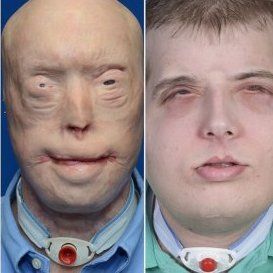Article
NYU Langone Surgeon Completes Most Extensive Face Transplant Ever
Author(s):
Eduardo D. Rodriguez, MD, DDS, Plastic Surgeon at NYU Langone Medical Center, and his team recently successfully completed a groundbreaking and complex face transplant.

Eduardo D. Rodriguez, MD, DDS, Plastic Surgeon at NYU Langone Medical Center, and his team recently successfully completed a groundbreaking and complex face transplant.
Rodriguez and team of 100 physicians, nurses, technical staff, and support staff conducted a 26-hour surgical procedure (initiated on the morning of August 14, 2015) for 41-year-old Patrick Hardison, a first responder from Senatobia, MS, who experienced extensive facial burns in September 2001 in the line of duty as a volunteer firefighter.
The replacement face belonged to 26-year-old David Rodebaugh, a Brooklyn bike mechanic, who died from a bike accident. Landing on his head, Rodebaugh was declared brain dead just 48 hours prior to the miracle surgery.
Hardison was injured after entering a burning home on a rescue search.
A collapsed roof left disfiguring burns across his entire face, head, neck, and upper torso. As a result, Hardison lost his eyelids, ears, lips, eyebrows, hair, and most of his nose.
Following more than a decade of 71 surgeries, and a harrowing battle with pain medication addiction, Hardison was finally referred to Rodriguez and evaluated for a face transplant.
“When I met Patrick and heard his story, I knew that I had to do all I could to help him — and every member of my team felt the same way. His surgery sets new standards in facial transplantation and will serve as an amazing learning tool. We could not have helped Patrick without amazing teamwork,” said Rodriguez in a press conference Monday morning.
There was a year of tedious preparation. Patient selection was imperative to Rodriguez — he wanted to work with a patient who not only understood all of the surgical risks, but also was one who would readily accept post-surgical follow up regarding daily medications and regular appointments.
As for the “perfect” donor, Rodriguez was seeking someone who matched Hardison in skeletal structure, not simply skin color, hair color, and blood type.
Additionally, they weeded out potential donors who had significant exposures to IV drug use, tattoos, and facial injuries. Rodriguez even considered specific distances of their eyes, nose, mouth, and lips.
While the jugular was not a perfect match, and Hardison did lose a lot of blood, the most difficult part, according to Rodriguez, was connecting the blood vessels.
But their scrutiny proved effective as Rodriguez and team successfully provided Hardison with a new face, scalp, ears, eyelids, and selected parts of bone from the chin, cheeks, and entire nose.
Post-operative care has indeed been strenuous. Seven weeks later with numerous therapy sessions under his belt, Hardison is still in NY focusing on recovering as his face has taken on a different look adapting to Hardison’s bone structure.
Click here to read an in-depth profile of Dr. Rodriguez and his work, including a video interview.





